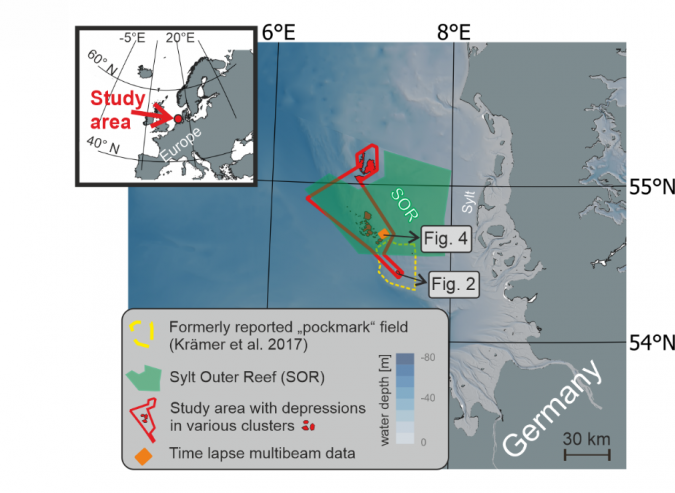Decoded secrets of millions of mysterious ocean pits
World oceans host diverse creatures that shape the seafloor. In a groundbreaking interdisciplinary study published in Communications Earth & Environment, Kiel University geoscientists, alongside biology and oceanography experts, have linked crater-like depressions in the North Sea to porpoise and sand eel habitats. This offers a first comprehensive explanation of the influence of vertebrates on seafloor contours.
The North Sea floor hosts numerous crater-like depressions known as pockmarks, and there are millions of these worldwide. Traditionally attributed to fluid discharge, for example of methane or groundwater, these formations often baffle researchers. Dr Jens Schneider von Deimling, lead author from Kiel University, revealed: “Our results show that these depressions are linked to porpoise and sand eel habitats, not rising fluids.” The high-resolution data suggests a global occurrence overlooked until now. The study, involving researchers from Kiel University, the Alfred Wegener Institute, the University of Veterinary Medicine Hannover and the Leibniz Institute for Baltic Sea Research Warnemünde, examined the North Sea seafloor, emphasizing vertebrate behaviour analysis.
The team suspects that most of the depressions in the seafloor in the German Bight are created by porpoises and other animals searching for food, then scoured out by bottom currents. The sand eel, a small eel-like fish that spends most of the year buried in shallow sediments, plays a key role in this process. Sand eels are not only popular with the fishing industry, but are also consumed in large quantities by porpoises. “From analyses of the stomach contents of stranded porpoises, we know that sand eels are an important food source for the North Sea population,” stated Dr Anita Gilles of the TiHo-Institute for Terrestrial and Aquatic Wildlife Research (ITAW), who has long studied the biology of marine mammals. In their study, the researchers showed that the marine mammals leave pits in the seafloor when they hunt for buried sand eels. Although these pits resemble the familiar pockmarks, they are much shallower.
Advanced echosounder assesses pit condition
Detection of these pits has only become possible in recent years, with the help of modern multibeam echosounder technology, which is taught and practiced intensively at Kiel University. “The formation mechanism of these pits, as we call them, probably also explains the existence of numerous crater-like depressions on the seafloor worldwide, which have been misinterpreted as the result of methane gas leaks,” said geoscientist Schneider von Deimling. In the North Sea, the researchers identified 42,458 of these enigmatically shaped, shallow pits with an average depth of just 11 centimetres, which differ in their morphology from the more conical craters of the pockmarks.
Schneider von Deimling works in the Kiel Marine Geophysics and Hydroacoustics working group at the Institute of Geosciences and the Kiel Marine Science (KMS) priority research area at Kiel University, and is vice chairman of the German Hydrographic Society (DHyG). As an expert in seafloor mapping, methane gas seepage and seafloor pockmarks, he never believed that the depressions in the German Bight were caused by rising fluids. “We had to come up with an alternative hypothesis for their formation. This allowed us to predict where potential porpoise feeding sites are, and that is exactly where we found the pits – always close to sand eel habitats. Our extensive and multidisciplinary data analysis now provides a conclusive explanation for our harbour porpoise pits hypothesis.”
Cross-disciplinary exploration
Key to the new findings was an interdisciplinary approach that brought together geological studies, geophysical sonar measurements, vertebrate behaviour and feeding biology, satellite evaluation and oceanographic analysis. By precisely analysing millions of echosoundings collected by German research vessels, the researchers were able to locate the unusual pits. “Using special echo sounding methods, we can now measure the seafloor with centimetre precision and thus find the shallow pits. We can also look into the seafloor and see, for example, whether there is free methane gas,” explained AWI researcher Dr Jasper Hoffmann. Analysing the data collected by research vessels over thousands of nautical miles was a mammoth task. “With modern methods, such structures can be automatically detected and characterized in acoustic datasets and automatically analysed in large datasets,” said Dr Jacob Geersen, co-author of the study.
The research team suggests that initial feeding pits act as a core for scouring, evolving into larger pits – a discovery with global implications. Vertebrate-induced sediment scouring in oceans could potentially influence benthic ecosystems and seafloor modulation worldwide. In the study area alone, pits cover 9% of the seafloor, depositing an estimated 773,369 tons of sediment across 1,581km², roughly equivalent to the weight of half a million cars. Schneider von Deimling concludes that these findings hold significance for both geological and biological aspects, aiding in the evaluation of ecological risks related to offshore renewable energy expansion and enhancing marine environmental protection.















